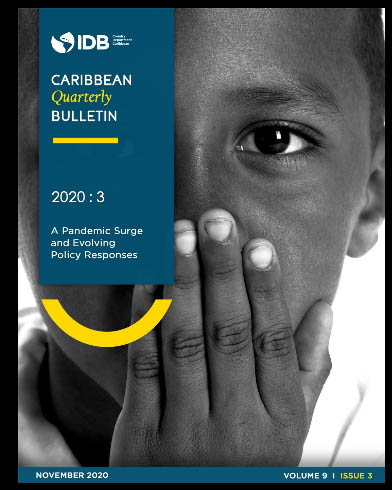Caribbean governments including Guyana are being encouraged to invest in infrastructure as a means to stimulate the local economy post COVID-19.
“A well-designed public investment programme can help stimulate the economic recovery,” a report from the Inter-American Development Bank advised explaining that while fiscal space will remain a constraint, additional resources could be channeled to high-productivity infrastructure products to further stimulate growth.
The report – “A Pandemic Surge and Evolving Policy Responses” – is part of the Quarterly Bulletin Series put together by the economics team of the Caribbean Department of the IDB. It includes detailed analyses for Guyana, Jamaica, Barbados, The Bahamas, Suriname and Trinidad and Tobago.
The report stresses that the pandemic’s impact on economies is without precedent and likely to extend into the next decade particularly for countries that depend on external demand, including for tourism and commodities exports.
The impact has already been recorded as significant contraction in the first half of 2020 while policy focuses on stopping the spread of the virus. In Guyana the International Monetary Fund (IMF) has already revised Guyana’s GDP growth estimate down twice, first from 85.6 to 52.8 % and now to 26.2%.
The pandemic and the resultant closure of non-essential economic activity has led to contractions in most sectors.
The services sector, which makes up 45% of the economy, is potentially the most exposed sector to social distancing policies. This sector declined by 3.8 % the first half of the year, with wholesale and retail trade falling by 14.7 %, transportation and storage by 25%, and accommodation and food services by 32.9 %. The construction sector, which had been growing at relatively high rates prior to the pandemic, fell by 5.6 %.
The largest productive sector of the economy, agriculture (17.6 % of GDP), suffered a contraction of 4.1 % in the first half of 2020. However, rice production is expected to expand by around 3 % in 2020, which would contribute to mitigating the contraction in agriculture.
The country however continues to be buoyed by the mining industry. Guyana’s second largest sector with 14.9 % of GDP (and which now includes oil production), expanded by 343.7 % in the first semester, after oil production began in December 2019.
Gold production, representing almost 10 % of GDP, grew by 2.1 % in the first half of the year, bolstered by historically high prices of gold.
As countries move to adapt to the reality of COVID-19, the report stresses that it would take years for these sectors to recover. Consequently, they argue, it is crucially important that countries facing large and increasingly binding financial constraints ensure that their interventions are well-targeted, appropriate to the objective, and adequately dimensioned.
Spectrum
So far governments around the world have deployed a broad spectrum of measures, focused primarily on three key objectives: (i) maintaining financial stability, (ii) supporting households through the crisis, and (iii) ensuring that corporates particular small and micro-enterprises remain in operation and viable.
In the region governments have, the report explains, responded with appropriate and targeted expenditures to alleviate the social and economic impact of the recession.
They have engaged in direct expenditures to combat the health crisis, directed expenditures or tax reductions to households and firms, accelerated spending or deferred revenue and, finally, offered
liquidity support via equity or loans to firms or guarantees.
In Guyana specifically the report reminds that since the outbreak of the COVID-19 pandemic in Guyana on March 11, 2020, the government has been in transition, with new authorities taking office in August.
“Initially in March, the government’s policy response focused on containing the spread of the virus by introducing restrictive measures that included closing schools, non-essential businesses, and both international airports, and by supporting the health sector with equipment and hospital facilities, tax relief, and distributed food supplies,” it explains adding that more recently, the authorities introduced additional tax policy measures and extended flexibility in the financial sector, support to the health sector, and relief to vulnerable households.
The fiscal response included a series of tax measures to provide relief and support to the private sector. Cumulatively authorities estimated that these measures will generate savings of approximately US$96 million (G$20 billion) for the private sector.
Additional measures include the allocation of US$21.6 million (G$.5 billion) to support household welfare with cash transfers of US$120 ($25,000) per household. The government also announced plans to obtain US$60 million in loans from multilateral organizations that would potentially be used to fund these programmes.
In the financial sector, the Bank of Guyana has extended the relief period and introduced measures to support liquidity and lower financial costs.
The Bank of Guyana had originally encouraged commercial banks to defer loan repayments to customers and companies in good standing and adjust corresponding account classifications to cushion non-performing loans through the end of the year. To support liquidity, the central bank reduced a series of policy rates such as reserve requirements, liquid asset requirements for demand deposits, and savings and time deposits. Finally, commercial banks agreed to provide short-term loans at concessional rates between 5 and 6 %, lower than the prime lending rate of 10.3 %.
The report recommends that one crucial policy option with considerable potential for both near-term stimulus and long-term development impact is public investment.
“Standard economic theory and related evidence suggests that public investment multipliers— that is, the influence that public investment has on national output—can be quite large, particularly when compared with government primary expenditure and other forms of public consumption,” the report notes, explaining that increasing an economy’s productive capacity through better roads or airports to facilitate the transport of goods and services to market and improved water and power infrastructure enables industry to operate at lower costs.
“Public investment increases the marginal product of capital and labor. Over time, that in turn drives higher levels of private investment, incomes, and consumption…every additional dollar of appropriately designed and executed public investment can have the highest potential returns,” the report states while adding that Caribbean countries are particularly well placed to benefit from increased or accelerated public investment, in part because of the region’s significant needs.






